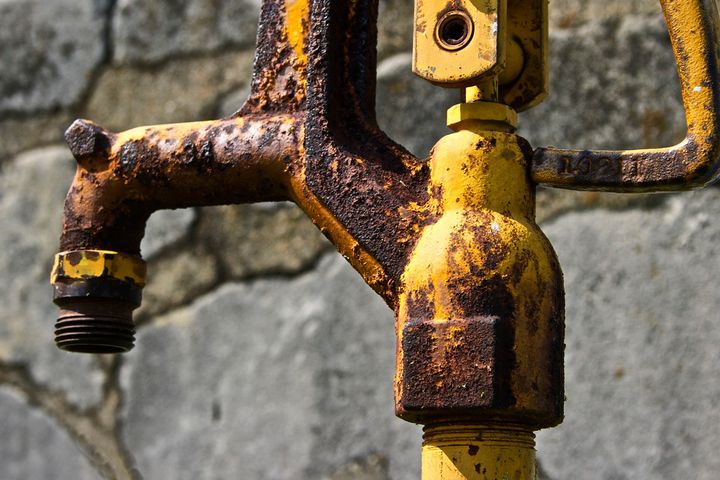
President Trump promised a bold plan to revitalize our national infrastructure — a multi-billion dollar investment in new roads, tunnels, bridges, railroads, and airports. (Not to mention that wall.) But if the former real estate mogul (and eponymous steak and bottled-water pitchman) really wants to "make America great again,” there’s one investment that promises a better return than others: rebuilding our crumbling U.S. water and sanitation infrastructure.
Underground pipes and water-treatment plants may not have the sex appeal of a shiny new airport, but they’re essential to our social and economic survival.
Here’s why:
Our water lines are literally falling apart.
Much of the country’s water infrastructure was built at the turn of the 20th century and is in an appalling state of disrepair. In Los Angeles, 20 percent of active water lines were laid prior to 1931. Many Angelenos remember the 2014 failure of a 93-year water main which flooded portions of the UCLA campus, causing $13 million in damage. But Los Angeles isn’t alone; such failures are part of a growing, nation-wide epidemic.
An estimated 240,000 water mains break each year — roughly 27 every hour. The cost of plugging these leaks is estimated at $2.6 billion annually, but the real cost is far higher. The American Society of Civil Engineers (ASCE) estimates that water outages between 2013-2020 will cost U.S. businesses $147 billion, and U.S households $59 billion.
Each year, up to 18 percent of the U.S. treated water supply — about 2.1 trillion gallons — vanishes through busted mains, leaky pipes and faulty meters. That’s more than enough to fill every public pool in the country. (The amount of water lost in Chicago every year could more than serve the population of Denver.) The problem will only grow with time. While the iron pipes laid in the late 19th century were expected to last 120 years, water mains constructed during the post-war building boom have a projected life of only 75 years. Both need to be replaced, and fast.
Millions of Americans still drink dirty water.
When people think of filthy tap water, they think of Flint, Michigan, where a combination of aging infrastructure and nefarious leadership created a lead-contamination crisis that’s still grabbing headlines three years later. But Flint isn't the whole story. In March 2016 USA Today reported that more than 2,000 water systems in all 50 states were found to have lead levels exceeding federal limits (currently 15 parts-per-billion, but health officials warn that no amount of lead is safe). Collectively, those systems serve some six million people. In California, where groundwater is sometimes contaminated with arsenic and toxic agricultural runoff, an estimated 1.5 million people still receive drinking water that doesn’t meet health and safety standards.
Too many Americans still don’t have any access to clean, running water.
Well into the 21st century, there are still pockets of extreme “water poverty” in the U.S. — places where families don’t have running water or basic sanitation facilities. According to 2016 Census data, more than 500,000 U.S. homes lack running water or basic plumbing, like a shower or a toilet. We are the only developed country with a water-access problem of this magnitude.
DigDeep, the organization I lead, is currently working to improve water access on the Navajo Nation, where an estimated 40 percent of the 170,000 residents still have no clean, running water at home. It’s common for families there to drive up to 50 miles to fill jugs or buckets with the water they need to survive. Many Navajo get by on fewer than five gallons of water per day; the typical American uses about 100.
Rural communities without water, like the Navajo Nation, need our immediate attention, but in the decades ahead, those most affected by our crumbling water infrastructure will be working- and middle-class Americans — two demographics that Trump promised to champion. Without urgent investment in water, they face significant economic losses, compromised health, and even the possibility of civil unrest. Inequities in water access are at the heart of several recent social conflicts, like the clash over indigenous rights and the environment on the Standing Rock Reservation and the fight against massive water shutoffs in Detroit.
Replacing or improving our worn-out water systems is imperative. But it won’t be cheap, and will require a strong political will. According to the American Water Works Association (AWWA), repairing and expanding drinking water infrastructure will cost more than $1 trillion over the next 25 years. Perhaps President Trump won't have the foresight or the political capital to make it happen. If he does, however, we’ll see a strong return on that investment — the ASCE projects that even a “modest” increase in water-infrastructure investment would protect $416 billion in GDP; prevent 700,000 job losses; and avert $541 billion of lost personal income.
Smart, comprehensive water investments will create economic opportunity, improve health, and make our country more resilient in the face of growing water shortages, especially in the western states. More importantly, a historic investment in water and wastewater infrastructure (accompanied by appropriate environmental protections) would meaningfully improve the lives of some of the most marginalized Americans.
If Trump wishes to keep his campaign promises to working- and middle-class Americans, he should focus on rebuilding our water-supply. That's some Trump™ Water I’d be willing to buy.
